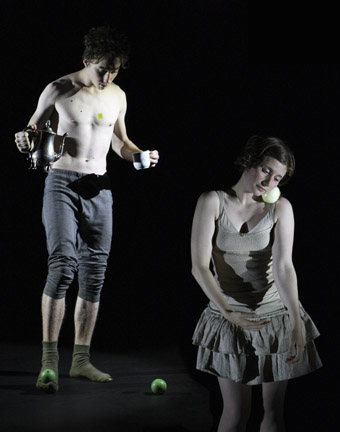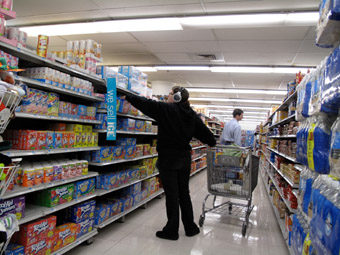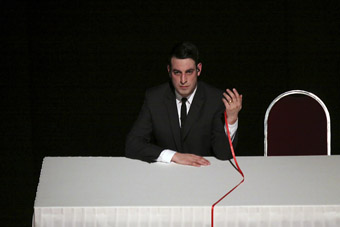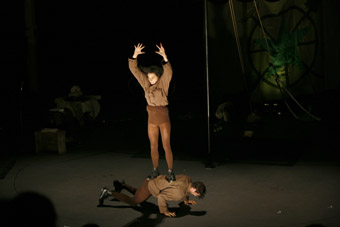minus signs
jana perkovic: contemporary performance at arts house

Silvertree & Gellman, Scattered Tacks
photo Alicia Ardern
Silvertree & Gellman, Scattered Tacks
THE NEXT DECADE IN THEATRE AND CONTEMPORARY PERFORMANCE WILL BE A DECADE OF PHENOMENA, NOT OF SIGNS, OF EXPERIENCING RATHER THAN READING PERFORMANCE. THE FIRST ‘SEMESTER’ OF THE ARTS HOUSE 2010 PROGRAM COULD BE NEATLY DIVIDED IN TWO PARTS: AUSTRALIAN CONTEMPORARY CIRCUS AND UK-BASED RELATIONAL PERFORMANCE. THE LATTER (WHERE THE AUDIENCE BECOME PERFORMERS AND CO-CREATORS) IS A BACKLASH AGAINST 20 YEARS OF MEDIATISED POSTMODERN THEATRE.
These new works are theatre minus stage, performance minus performers and spectacle minus the spectacular. The audience experience is the event itself: tactile, immediate, immersive, anti-ironic. The semiotic component is minimal, sometimes altogether absent, as the performance exists mainly in the mind of the spectator. It appears, perhaps, as our era abandons questions of meaning and engages with amplified possibilities of doing. It’s almost like a direct answer to Deleuze’s dream of the new non-representational theatre, in which “we experience pure forces, dynamic lines in space which act without intermediary upon the spirit.” And although tested by performance-makers both here (bettybooke, Panther) and elsewhere (Rimini Protokoll), the UK, building on its rich variety of live art, is something of a leader.
This form is too young to have encountered much meaningful criticism in Australia, but every form quickly accumulates knowledge. While I don’t think everything we have seen at Arts House could be called successful, the failures are just as interesting, like the results of an experiment.
Take Rotozaza. Their two shows, Etiquette and Wondermart, promised a new form of expression, ‘autoteatro,’ but delivered a half-hearted combination of pomo referentiality and demanding, mediatised interactivity. Both are no more than voices inside a headset, giving instructions to a single audience member. Wondermart is a walk through a(ny) supermarket. Etiquette is 30 minutes in a café, in which you and another audience member perform an encounter, a conversation from Jean Luc Godard’s Vivre Sa Vie, the final scene from Ibsen’s A Doll’s House, and much else—sometimes by talking to each other, sometimes moving figurines on the chess board in front of you.

Wondermart, Rotozaza
photo Ant Hampton
Wondermart, Rotozaza
While very engaging in those few moments when the narration matches what’s happening in space (such as when theories of shopper behaviour are confirmed by innocent bystanders in the supermarket), most of both shows consisted of a series of mundane and tiring little tasks. Despite the interactive pretences, they were not so much an experience for one audience member as a performance by one audience member, with the concomitant stage anxiety—even if nobody was watching. The problem was not just that many aspects of the situation cannot be sufficiently controlled by the audience-performer (my noisy supermarket trolley forbade me from following shoppers as instructed; or the concentration required to both quickly deliver lines and hear your partner-in-dialogue). Rotozaza underestimate our anxiety not to let the performance down: a compulsive need to please the dictatorial voice inside the headphones by performing everything right.

Mem Morrison, Ringside
photo National Museum of Singapore/Chris P
Mem Morrison, Ringside
If Rotozaza forgot how unpleasant structured events can be, Mem Morrison went all the way and staged the worst aspects of a wedding ceremony in Ringside. Its entire conceptual spine is the sense of alienation, monotony, meaninglessness and loneliness one feels at a collective ritual. The performance starts before it starts—audience groups are arranged into family photos, well-dressed and carnation-studded as per instructions—and seated around one long table. An infinite number of black-clad women, both attendants, family and brides-to-be, deliver food and crockery. Amidst the flurry Morrison is the only male, unhappy, confused, 12 years old, jokingly told it’s his turn next, sometimes playing with a Superman toy and sometimes MC-ing with his shoe instead of a microphone.
Ringside’s aspirations are sky-high, but the performance never manages to reveal much of its topical menagerie: ethnicity, gender, tradition, multiculturalism are signposted rather than explored or experienced. Morrison’s entire text is delivered through headphones, creating a mediatised distance that in 2010, after 20 years of screens onstage, is as déjà-vu as it is genuinely disengaging. There is a paradox within Ringside: it purports to bring forth an aspect of Turkish culture, but the distanciation intrinsic to the method condemns it as facile. The experience is ultimately of witnessing a whining 12-year-old, loudly airing his discontent at being dragged to a family event.
Helen Cole’s Collecting Fireworks, on the other hand, a performance archive and an archive-performance, is as simple as it is brilliant. A genuine one-on-one performance (a dark room, a single armchair, recorded voices describing their favourite performance works, followed by recording one’s own contribution), it exemplifies the opening possibilities of this new form: no stage, no performers, but a deeply meaningful experience. I suspect the end result will be a genuinely valuable archive of performance projects, as we are encouraged to remember not only the details of these works, but also the effect they had on us.
The reasons the two local circus performances were on the whole much more successful are complex: Australia’s long tradition of contemporary circus and Melbourne’s close acquaintance with both the form and the artists are not the least important. If with relational performance, imported from an emerging artistic ecology overseas, we occasionally felt both short-changed and ignorant, with circus we could comfortably feel at the world’s cutting edge.

Propaganda, acrobat
photo Ponch Hawkes
Propaganda, acrobat
Acrobat’s long-awaited new work, Propaganda, points to the long tradition of circus used as Soviet agitprop, educational art dreamt up by Lenin in 1919 as “the true art of the people.” The company’s take is both ironic and deeply earnest, and it takes weeks of confusion before concluding that, yes, their open endorsement of cycling, eating veggies and gardening nude was serious. The tongue is in cheek, yes, when spouses Jo Lancaster and Simon Yates heroically kiss in the grand finale, centrally framed to the tune of Advance Australia Fair like the ideal Man and Woman in social-realist art. But it is a very slight joke indeed.
The specificity of circus could be defined as the pendular motion between crude and dangerous reality and the illusion of spectacle: relying on physical strength more than on representational techniques (it is impossible to just ‘act’ a trapeze trick), it can never completely remove the real from the stage. Acrobat’s previous (and better) work—titled smaller, poorer, cheaper—created tension by opening up the spectacle to reveal the hidden extent of the real: social stereotypes and obligations, physical strain, illness. Propaganda foregrounds circus as this family’s life: from the two children pottering around to the unmistakable tenderness between Lancaster and Yates and the heart-on-sleeve honesty of the beliefs they propagate. The dramaturgical incongruence between the ironic self-consciousness of the Soviet theme, with its inevitably negative undercurrent, and the performers’ trademark lack of pretence, remained the least fortunate aspect of the work. From the message to the magnificent skills on display, everything else was flawless.
Scattered Tacks, by Skye and Aelx Gellman and Terri Cat Silvertree (see article), stripped away spectacle to reveal the essence of circus: awe. Circus is a naturally postdramatic form: its narrative arc fragmented, aware of its own performativity (what Muller called “the potentially dying body onstage”) and constantly anxious about the irruption of reality on stage. Scattered Tacks is raw circus, naked: at times it felt like an austere essay in thrill. It revealed that the rhythm of audience suspense and relief hinges less on the grand drama of leaps and tricks and more on visceral awareness of the subtle dangers and pain involved. Eating an onion, climbing barefoot on rough-edged metal cylinders, overworking an already fatigued body—these were the acts that left the audience breathless. Yet they also achieve poignant beauty. The Gellmans and Silvertree bring Australian circus, traditionally rough and bawdy, closer to its conceptual and elegant French sibling, but in a way that is absolutely authentic.
Australia offers a good vantage point from which to observe the human being. Visiting Europe recently, it struck me how dense the semantics of the European theatre are in comparison. Performing bodies there are acculturated and heavy under the many layers of interpretation, history, meaning. The body here, on the other hand, easily overpowers the thin semiotics of Australian culture, emerging strong, bold and without adjectives, without intermediary. Body as phenomenon, not as signifier. It will be interesting to observe how the emerging interest in theatre as presence, rather than representation of meaning, unravels—and how much this country will participate in this trend. In this season it’s circus, one of the oldest forms of performance, that emerges as the more successful. The relational performance works only rarely overcame the trap of referentiality.
Arts House: Rotozaza, Etiquette, Wondermart, co-directors Silvia Mercuriali and Ant Hampton, Arts House and around Melbourne; Mar 16–April 3; Mem Morrison Company, Ringside, writer, director, concept, performance Mem Morrison, sound & music composition Andy Pink, design Stefi Orazi, North Melbourne Town Hall, March 17-21; Helen Cole, Collecting Fireworks, director Helen Cole, technical consultant Alex Bradley, North Melbourne Town Hall, March 17-19; Acrobat, Propaganda, conceived and performed by Simon Yates and Jo Lancaster, also featuring Grover or Fidel Lancaster-Cole, Meat Market, March 27-April 3; Silvertree and Gellman, Scattered Tacks, created and performed by Terri Cat Silvertree, Alex Gellmann, Skye Gellmann, Arts House, Meat Market, Melbourne, March 16-21
RealTime issue #97 June-July 2010 pg. 33






